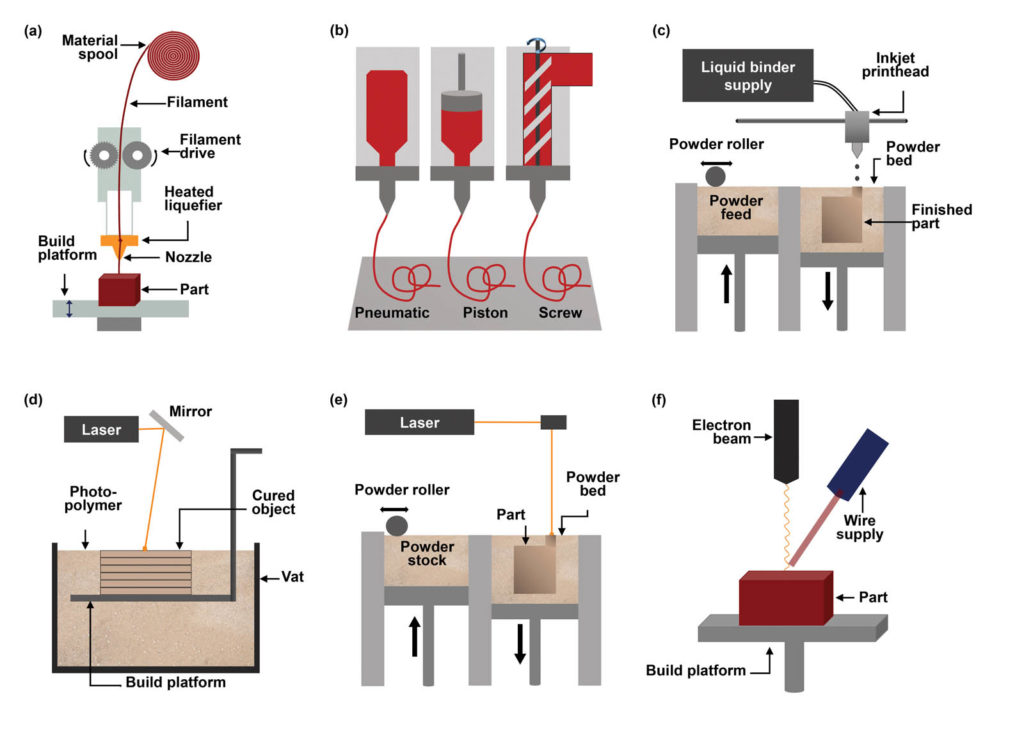
3D printed textiles can be viable in the industry.
by Kony Chatterjee and Tushar K. Ghosh
The advent of 3D printing (3DP) has drawn considerable interest from academia, industry and amateur hobbyists as a novel method of producing objects layer-by-layer (LbL) via a bottom-up manufacturing approach. This method of “additive” manufacturing (used interchangeably with the term 3DP) builds objects via the addition of material and subsequent solidification (if needed), distinct from the traditional subtractive manufacturing methods where material is removed from a block of material to create the object.
Using 3DP methods, objects ranging from a few micrometers to many meters in size, from soft elastomers to hard ceramics and metals, and from solid to porous structures can be manufactured. While many fields of research and industry have benefited from 3DP, textile manufacturing has yet to fully embrace 3DP technologies. This is due to the uniqueness of textile materials as well as textile structures; fiber-forming polymers are limited in number and not easily usable in current 3DP technologies. Additionally, textile structures themselves require heterogeneity and programmed discontinuities that are difficult to achieve at high resolutions via current 3DP methods.
Promising technologies
The term 3DP is broadly used to include many specific technologies that are distinguished by the form (liquid or solid) of the starting or raw material, how the material is deposited (via nozzles or a vat of material), and how the object is solidified (heat or light hardened).
Two 3DP techniques show promise for application in textile technology—material extrusion and vat photopolymerization. Material extrusion 3DP processes involve pushing material through a programmable nozzle onto a computer-controlled translational stage to create 3D parts, LbL. This includes filament-based extrusion where a thermoplastic filament is melted for use as the printing material and techniques such as fused deposition modeling (FDM) and direct ink writing (DIW).
The other material extrusion technique involves droplet-based extrusion such as inkjet printing and direct-on-demand printing. In droplet-based extrusion, the printing material is usually a low viscosity fluid that solidifies upon deposition on a substrate to form the part. Vat photopolymerization (also known as stereolithography or SLA, forms 3D parts by solidification of photopolymers—soft materials that undergo solidification from liquid to solid upon exposure to ultraviolet (UV) light, and in some cases visible light.
Limitations
Textiles are produced via unique methods of manufacturing and assembly. Over thousands of years their fundamental underlying structure has remained unchanged; in the hierarchy of textile structures, fibers of high aspect ratios (length orders of a magnitude greater than diameter) are assembled into yarns, which are then woven or knitted into fabrics.
Alternatively, fabrics can be produced directly from fibers or polymers to form nonwovens. The fabrics are subsequently made into products. This hierarchy of structure is necessary to obtain seemingly conflicting performance requirements of textiles, e.g., strength and flexibility. Throughout the textile manufacturing process, the starting raw material (polymer) undergoes extensive changes in mechanical properties and porosity.
Moreover, most textiles are composed of only a narrow subset of fiber-forming polymers: cellulosics, proteins, polyamides (PAs), polyesters including polyethylene terephthalate (PET) and polybutylene terephthalate (PBT), polyacrylonitriles (PANs) and polyolefins including polypropylene (PP) and polyethylene (PE). The fiber-forming polymers can be considered a unique subset within the broader range of polymers, and this also limits the 3DP methods that can be used to manufacture textiles.
Some of the currently used materials in various 3DP technologies can possibly be used in certain specialty technical textile applications such as polycaprolactone, PP and PA in techniques such as direct ink writing and FDM, and polymer powders of nylon and polyurethane (PU) in selective laser sintering (SLS) techniques. However, adaptation of these materials to make conventionally used textile fabrics remains a challenge.
Another important aspect of textiles to consider is their programmed inhomogeneity and anisotropy that enables them to have a structure with voids and directional properties. What is considered a “defect” in other applications is a necessity in textiles to provide breathability, comfort and flexibility to fabrics.
Certain applications of 3DP techniques, while not directly related to textile 3DP, have created structures with planned heterogeneity and voids, mainly for use in biological systems such as tissue scaffolds. These include using an integrated tissue-organ printer (ITOP) to create human-scale tissue constructs composed of cell-laden hydrogels and biodegradable polymers, and continuous liquid interface production (CLIP), a type of vat photopolymerization technique, to create layerless and seamless voided structures ranging from 50 micrometers to more than 20 centimeters.

Garments vs. textile structures
Some researchers and designers have created wearable garments from 3DP processes, such as using SLS of PA to create a drape dress in a chainmail design; SLS made thin PU filaments layered together to make a lace-textured dress; and 3D printed fluidic channels combined to form a wearable product. But these are not textiles by any definition; rather, they are rigid pieces joined/layered together to exhibit drape.
In other applications, 3DP has been used to decorate the surface of existing textiles, including using FDM to print cellulose, polylactic acid (PLA), acrylonitrile butadiene styrene (ABS) and nylon onto woven and knitted fabrics. Again, these are restricted to surface decoration of already produced textiles. The adoption of 3DP in manufacturing textiles should primarily focus on reproducing the essential properties of textiles: softness, flexibility, strength and porosity.
An interesting method of achieving this combines fiber formation, robot-assisted dispensation of material and today’s 3DP technology. Termed at the time as robotic fiber assembly and control system (RFACS), it was tailored to deposit meltblown nonwoven fiber webs onto a mannequin-shaped mold, thereby forming a tailored garment in a single step without any seams or joints. Exploration is ongoing regarding the applicability of RFACS in the future adoption of 3DP into textile manufacturing (termed as printing with fibers).
The good news
Finally, it is also important to highlight that while factors such as types of polymers available, development of a fine fiber structure, and obtaining acceptable resolution at a textile fiber scale limit current 3DP techniques, overall the technology is very promising for fundamentally transforming textile manufacturing.
Increased globalization, offshoring and reliance on a low-cost supply chain have contributed to the decline of the once robust domestic textile industry in the U.S.; however, disruptive manufacturing techniques such as 3DP of textiles and a trained workforce present an opportunity to resurrect textile manufacturing.
The increasing availability of low-cost robotics, automation and cloud computing should enable local manufacturing and low-cost customization of textiles using appropriately developed 3DP of textiles. In the long run, 3DP has the potential to significantly improve the supply chain through mass customization, environmental and social sustainability, sensible raw material usage and onshore manufacturing, and, thereby, comprehensively advance the competitiveness of the U.S. textile manufacturing infrastructure.
Kony Chatterjee is a senior doctoral student and Tushar K. Ghosh, Ph.D., is the William A. Klopman Distinguished Professor, Wilson College of Textiles, North Carolina State University, Raleigh.
A complete list of references is available upon request: jlpreus@ifai.com.
 TEXTILES.ORG
TEXTILES.ORG


